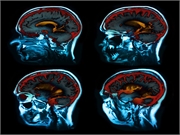THURSDAY, Oct. 15, 2020 (HealthDay News) — Offering fresh insight into the deep-seated roots of dementia, new research finds that diminished blood flow to the brain is tied to buildup a protein long associated with Alzheimer’s disease.
Called “tau,” high levels of the protein are “one of the hallmark pathologies that define Alzheimer’s disease in the brain,” explained study author Judy Pa. She is an associate professor of neurology with the Mark and Mary Stevens Neuroimaging and Informatics Institute and the Alzheimer’s Disease Research Center at the University of Southern California.
“Tau tangles very closely track Alzheimer’s disease progression, such that when the number of tau tangles in the brain increases, problems in memory and thinking will also increase,” Pa noted.
And the new investigation indicates that “decreased blood flow [is] associated with increased tau in brain areas important for Alzheimer’s disease,” Pa added.
According to the U.S. National Institute on Aging, the brain’s billions of neurons work tirelessly to ensure proper nervous system communication and healthy body function.
But that mission is seriously undermined when abnormal tangles of tau protein take up shop inside neurons. Yet, NIA experts and Pa both point out that poor vascular function –which often manifests as decreased cerebral blood flow– has also long been linked to Alzheimer’s risk.
“It is known that some risk factors for Alzheimer’s disease are associated with vascular health,” Pa noted, with risk going up among patients with high blood pressure and among those who smoke or are physically inactive.
But do tau tangles and poor blood flow in the brain go hand-in-hand? Pa’s team set out to find out.
Between 2016 and 2019, brain scans were conducted among a group of 68 men and women between the ages of 46 and 80. The group included patients who ran the gamut, from being mentally healthy to having mild cognitive impairment.
The scans revealed that brain areas with increased tau tangles were also subject to a drop in blood flow. This was particularly true in an area of the brain — known as the “inferior temporal gyrus”– that is believed to be among the first brain regions where tau buildup is seen in Alzheimer’s patients, even before obvious signs of thinking impairment become evident.
The team then poured over brain scan data collected between 2017 and 2019 concerning a separate group of 138 patients who had been enrolled in the “Alzheimer’s Disease Neuroimaging Initiative.” Patients included men and women with diagnoses ranging from mild cognitive impairment to full-blown Alzheimer’s dementia.
Again, the team found that a drop in cerebral blood flow overlapped with an increase in brain tangles.
“We then found that this association was stronger in those with poorer cognition and in those with higher amyloid pathology levels [plaques],” said Pa. That suggests that the “relationship between blood flow and tau is important and meaningful,” and that “maintaining vascular health is very important as one ages.”
The findings were published Oct. 12 in the Journal of Neuroscience.
“At the end of the day, we want to prevent Alzheimer’s disease before it happens,” said Pa. “And current research suggests that managing risk factors, including those that are vascular in nature, could aid in preventing or lowering Alzheimer’s risk.”
As a practical matter, that would mean trying to get those risk factors that are modifiable under better control, said Rebecca Edelmayer, director of scientific engagement with the Alzheimer’s Association.
“Age is clearly the biggest risk factor for Alzheimer’s,” she noted. “And genetics and family history also drive risk. But we’re doing a lot of research these days into different ways we can influence modifiable risk factors in order to support our cardiovascular health, because doing so may end up supporting not only our heart health but the vasculature of the brain.”
That, said Edelmayer, could mean eating better and exercising more, or reining in high blood pressure through a combination of medications and lifestyle changes.
But which comes first: poor vascular health or tau buildup? Edelmayer cautioned that the answer “remains unclear.”
“This research is exciting,” Edelmayer said. “But until we’re better able to understand the sequence of events that leads to Alzheimer’s, we can’t truly say that we know the causal factors.” That, she said, will require more research “that leaves no stone unturned.”
More information
There’s more on Alzheimer’s risk factors at the Alzheimer’s Association.
Copyright © 2026 HealthDay. All rights reserved.

